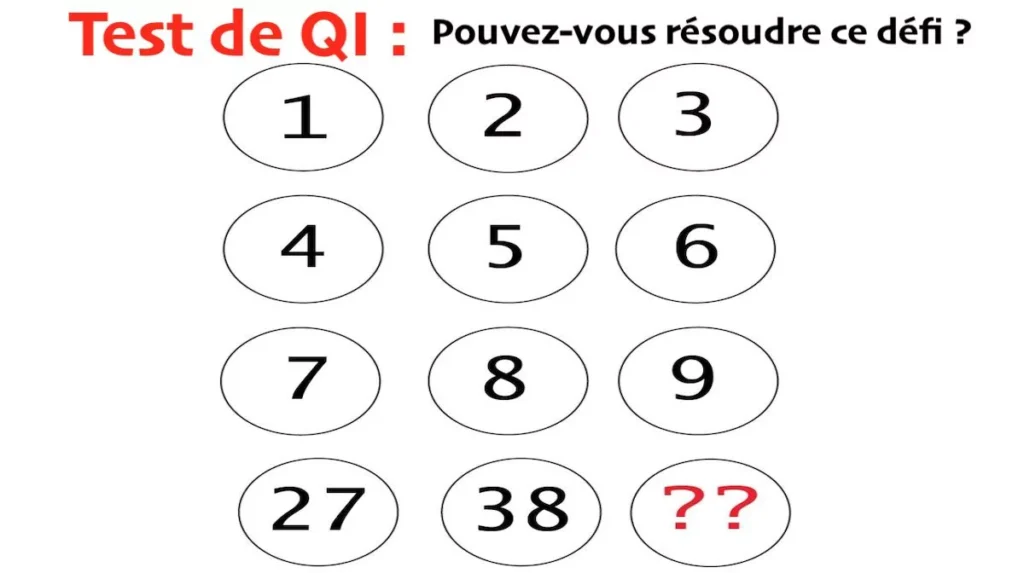A Math Puzzle That Set Social Media Ablaze
A new math challenge is currently circulating on social media, putting internet users to the test with an intriguing number grid. The goal? To find the missing number in a layout that appears simple… yet is misleading.
The Allure of Numerical Puzzles
Puzzles, particularly those based on mathematics, have long been a favorite pastime for curious minds. They not only test our logic and problem-solving skills but also sharpen our focus and mental agility.
Whether you solve them during a tea break or share them with friends, these challenges offer a genuine mental workout.
The Puzzle That Blocked the Internet
This new IQ test presents itself as a grid of numbers arranged in circles. The first three rows follow a straightforward progression:
- Row 1: 1, 2, 3
- Row 2: 4, 5, 6
- Row 3: 7, 8, 9
But the fourth row is perplexing:
- Row 4: 27, 38, ??
The question posed is clear: “IQ Test: Can you solve this challenge?”
Without hints or tips, only your logic and numerical instinct can guide you toward the right answer.
Another Viral Math Challenge
This isn’t the first time a math puzzle has gone viral.
Another example has already caused confusion:
The Appeal of Logical Challenges
Whether it’s a logical riddle or a mathematical challenge, these brainteasers continue to captivate. They are not just entertaining; they encourage critical thinking, stimulate the brain, and provide a unique satisfaction when the solution is found.
So, if you enjoy challenges and want to test your wits, try solving these puzzles. Who knows?
You might surprise yourself.
Here’s the Solution We Found:
Given grid:
- Row 1: 1, 2, 3
- Row 2: 4, 5, 6
- Row 3: 7, 8, 9
- Row 4: 27, 38, ??
We are looking for the logic that leads to 27, 38, ?? based on the three preceding rows.
Step 1: Observe the Positions
Let’s arrange the numbers in a table for clarity:
| Column 1 | Column 2 | Column 3 |
|---|---|---|
| 1 | 2 | 3 |
| 4 | 5 | 6 |
| 7 | 8 | 9 |
| 27 | 38 | ?? |
Step 2: Examine Column 1
Column 1 = 1, 4, 7
The sum is:
1 + 4 + 7 = 12
However, in row 4, we have 27 in the first position. This isn’t a simple sum.
Let’s test a pattern:
1 (row 1)
4 (row 2)
7 (row 3)
1 → 4 → 7: progression +3
This leads nowhere directly.
Now, let’s try this approach:
Column 1: 1, 4, 7
Let’s concatenate: 1 4 7 → 147 ?
Not 27.
Yet if we do:
1 × 1 = 1
4 × 2 = 8
7 × 3 = 21
Then: 1 + 8 + 21 = 30 → still not 27.
Step 3: Test Row by Row
Let’s look at it row by row.
Row 1: 1, 2, 3 → gives 27 below (row 4, first value)
Let’s try this:
1 + 2 + 3 = 6
1 × 2 × 3 = 6
(No clear link to 27)
And if we do:
1 × 2 = 2
2 × 3 = 6
1 × 3 = 3
→ Not conclusive
But look at this:
1×1 = 1
2×2 = 4
3×3 = 9
→ 1 + 4 + 9 = 14
Still not helpful. Let’s try something different.
Step 4: What if Each Row 4 Is the Sum of the Columns?
Let’s see:
Column 1:
1 + 4 + 7 = 12
Column 2:
2 + 5 + 8 = 15
Column 3:
3 + 6 + 9 = 18
Now:
Row 4:
1st box = 27
2nd = 38
3rd = ??
Let’s review the relationship between the sum of the columns and the fourth row numbers:
- Column 1 → sum = 12, but given value = 27
- Column 2 → sum = 15, but value = 38
Now:
27 – 12 = 15
38 – 15 = 23
→ Maybe a constant to add? But here 15, then 23… it’s varying.
New idea:
Consider this possible formula:
(row1 × row3) + row2
By column:
Column 1:
(1 × 7) + 4 = 7 + 4 = 11
≠ 27 → No.
Step 5: Let’s Try:
1st column:
(1 + 4) × 2 = 5 × 2 = 10
Still wrong.
Step 6: Let’s Use This Reasoning:
Looking at column 1:
1 + 4 + 7 = 12 → we have 27
If 12 → 27, that means we added 15
Column 2:
2 + 5 + 8 = 15 → we have 38
38 – 15 = 23
Column 3:
3 + 6 + 9 = 18
If the logic is:
Col 1 → +15
Col 2 → +23
Col 3 → +??
If we follow the pattern:
+15, +23 → progression +8
Thus, +31
18 + 31 = 49
Final Possible Answer: 49
Summary of Reasoning
- Sum the numbers in each column (from the first three rows).
- Add a growing number:
- Column 1 → +15
- Column 2 → +23
- Column 3 → +31
(Progression of +8)
- 3 + 6 + 9 = 18
18 + 31 = 49
And remember, if you don’t want to continue having fun with tests and challenges, definitely don’t click here.

